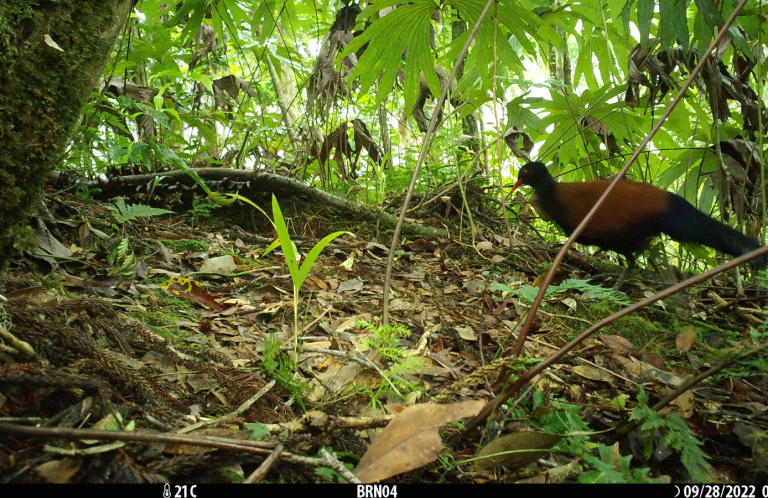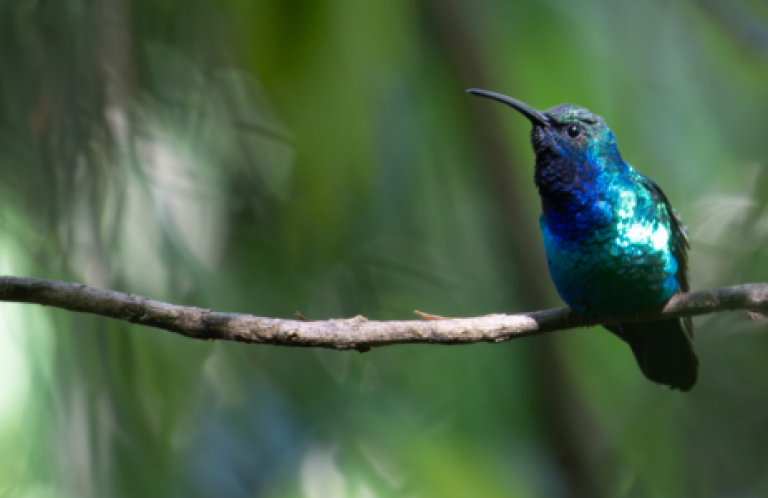Lost Bird for 55 Years: Rare Goshawk Photographed for First Time in Papua New Guinea

The New Britain Goshawk (Accipiter princeps) has been photographed for the very first time, confirm internationally-renowned ornithologists. Categorized as Vulnerable on the IUCN Red List of Threatened Species, the rare bird of prey is found only on the island of New Britain in Papua New Guinea.
“I was on a scoping trip with World Wildlife Fund (WWF) in Pomio (eastern New Britain), with three members of the local community guiding us through the forest, so we could better understand the presence of species. I photographed several bird species, including the New Britain Goshawk, but wasn't aware of the significance at the time,” said Fiji-based photographer, Tom Vierus, sharing how he secured the photograph.
Confirming the photographed bird as the New Britain Goshawk, John Mittermeier, Director of the Search for Lost Birds at American Bird Conservancy (ABC), said: “The last documented scientific record of the species appears to be a July 1969 specimen that is kept in the American Museum of Natural History in New York. While there have been multiple sight-only records in the intervening years, the New Britain Goshawk seems to have eluded photo, sound, and specimen documentation for 55 years.” The photograph and further details are now available on the websites of iNaturalist and Search for Lost Birds, a global partnership between ABC, BirdLife International, and Re:wild.
Oscar Pileng, who was born in Pomio and is WWF's Pomio-based officer, said: “I have discussed this discovery with local residents and leaders in the area where the New Britain Goshawk was photographed. They shared that this species is definitely rare in Pomio. Some confirmed that this species is not found in coastal areas but only in the hinterlands of Pomio, and is rarely seen. In local languages, the New Britain Goshawk is called ‘Keango' or ‘Kulingapa.'”
“I was amazed to hear that this is the first time it has been photographed, but am very happy that an official global record now exists and I hope that this means more efforts are made to protect its habitat from the threats of large-scale agriculture, logging, mining, and infrastructure development,” added Pileng.
On the invitation of local communities and government representatives, WWF is looking to further conservation efforts in Papua New Guinea by expanding its work to Pomio in East New Britain, where the photograph was captured. There, the Indigenous Mengen and Mamusi peoples maintain largely intact traditions and beliefs intrinsically linked to the forests, rivers, and oceans they have called home for millennia. Working closely with these matrilineal clan-based societies, WWF hopes to support local stewardship to safeguard the future of these incredible biodiversity hotspots through community-led conservation.
“There have been very few biodiversity studies in New Britain, and the potential for discovering species new to science is quite high. But it is a race to protect them, with pressures looming large and poverty a reality for many. WWF has begun a process of collaboration to understand the threats, livelihood opportunities, and social contexts, so we can collectively develop a comprehensive conservation program. We are actively seeking partners to help progress this important work,” said Martha Eimba, Pomio Landscape Manager, WWF-Papua New Guinea.
Papua New Guinea hosts the third-largest intact tropical forest in the world, following the Amazon and Congo basins. With more than 5,000 lakes, extensive river systems and wetlands, more than 8,000 kilometres of mangrove swamps, lagoons, coral reefs, and atolls, the country is remarkably diverse in terms of species, landscapes, and ecosystems. The government of Papua New Guinea is currently in the process of revising its National Biodiversity Strategy and Action Plan ahead of the United Nations Biodiversity Conference, taking place in Colombia in October 2024.
The forests where the bird was photographed are part of the Nakanai Ranges, a rugged and remarkably biodiverse expanse of green dotted mountains that form a section of the Sublime Karsts of Papua New Guinea, a tentative UNESCO World Heritage site. Scientists estimate the Ranges have been around for 22.5-10.5 million years.
“It was such a great surprise to hear that this photo seems to be the first-ever of this ‘lost species!' It is wonderful to see how conservation photography can help in safeguarding areas by documenting the existing biodiversity and also a good reminder of how important visual storytelling is. I truly hope this mostly pristine part of the world can remain as intact as possible with the help of the local communities, their already existing conservation initiatives, and the support of WWF,” added Vierus.
This press release was originally written and published by WWF Pacific.
###
American Bird Conservancy (ABC) takes bold action to conserve wild birds and their habitats throughout the Americas. Inspired by the wonder of birds, we achieve lasting results for the bird species most in need while also benefiting human communities, biodiversity, and the planet's fragile climate. Our every action is underpinned by science, strengthened by partnerships, and rooted in the belief that diverse perspectives yield stronger results. Founded as a nonprofit organization in 1994, ABC remains committed to safeguarding birds for generations to come. Join us! Together, we can do more to ensure birds thrive.
Tom Vierus is a photojournalist, filmmaker, marine biologist, and author. Originally from Germany, Tom has been living and working in Fiji for over six years. His work focuses mainly on the interaction of humans and their environment, often taking him to remote regions across the Pacific region. Tom is a member of the International League of Conservation Photographers and the Ocean Artist Society. tomvierus.com
WWF is an independent conservation organisation, with more than 38 million followers and a global network active through local leadership in over 100 countries. Our mission is to stop the degradation of the planet's natural environment and to build a future in which people live in harmony with nature, by conserving the world's biological diversity, ensuring that the use of renewable natural resources is sustainable, and promoting the reduction of pollution and wasteful consumption. Visit wwf.panda.org
Media Contact
Jordan Rutter
Director of Communications
media@abcbirds.org


















































